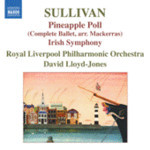
Sullivan: Pineapple Poll (arr. Charles Mackerras) / Symphony in E major, Irish
 $25.00
Out of Stock
$25.00
Out of Stock6+ weeks add to cart
ARTHUR SULLIVAN
Sullivan: Pineapple Poll (arr. Charles Mackerras) / Symphony in E major, Irish
Royal Liverpool Philharmonic Orchestra / David Lloyd-Jones
[ Naxos / CD ]
Release Date: Monday 8 October 2007
This item is currently out of stock. It may take 6 or more weeks to obtain from when you place your order as this is a specialist product.
As Sir Charles Mackerras writes in the booklet notes, the idea of transforming 'the eminently danceable tunes' of the Gilbert and Sullivan comic operas into a ballet score occurred to him while he was playing in the orchestra for a Gilbert and Sullivan season in Australia.
Sullivan was of partly Irish descent and his Symphony in E (later known as 'Irish' ) originated during a holiday in Northern Ireland when he was 21. He recounted the moment of its conception in a letter to his mother: 'the other night as I was jolting home… through wind and rain in an open jaunting-car, the whole first movement of a symphony came into my head with a real Irish flavour about it - besides scraps of other movements.'
Symphonies by Englishmen were rarities in the middle of the nineteenth century, especially by a young composer. Sullivan needed strong advocates to secure a performance and in the singer Jenny Lind (the so-called Swedish Nightingale) he found one. Her persuasion led August Manns to conduct the work at the Crystal Palace on 10 March 1866, when it was warmly received. A further performance the following month under the auspices of the Musical Society of London conducted by Alfred Mellon was a triumph, with applause after every movement and an ovation for Sullivan at the end.
Mendelssohn and Schubert are obvious influences on the work, but what is also abundantly evident is the freshness of Sullivan's melodic gifts as well as his technical fluency. The first movement opens with a slow introduction, beginning with a unison brass fanfare, which is answered serenely by a rising sequence of chords on the strings. The musicologist, the late Percy Young, noted the resemblance of the latter to the opening of the Cymbeline overture by Cipriani Potter (1792-1871), a composer, pianist and conductor active in London in the first half of the nineteeenth century. A lithe and wistful theme in E minor played by the first violins launches the Allegro ; this and the fanfare from the introduction feature prominently in the exposition and development sections, as well as the second main theme which has an ardent quality to its curved elegance. Sullivan's conclusion to the movement is particularly effective as he conjures a relentless momentum to bring it full circle with a final emphatic appearance of the fanfare.
The main theme of the Andante espressivo, heard initially on the horns, is relaxed, with a warm romantic lyricism. As the music slips between major and minor keys Schubert is called to mind. Both here and in the third movement Sullivan's natural flair for woodwind writing is apparent, as exemplified in the oboe melody, accompanied by delicate pizzicatos, that opens the scherzo in an inspired and original manner. It leads to a perky folksong-like tune with a distinct Irish flavour that Sullivan subsequently turns into a stately march. A short pastoral-like trio with muted strings provides an attractive foil to the scherzo.
High spirits characterise the opening of the finale. It is contrasted by a gentler rising theme ending with a cadence riven with Schubertian sadness. Later, a melody, first heard on the oboe, is combined in deft counterpoint with an overtly rhythmic theme in the first violins. Such a device was to become a hallmark of the composer in the double choruses of his operettas. Overall it is little wonder that the critic of The Times wrote of this remarkable youthful achievement that it was 'the best musical work, if judged only by the largeness of its form and the number of beautiful thoughts it contains, for a long time produced by an English composer.'
"…Charles Mackerras's ballet Pineapple Poll (1951) has become a light-music classic. David Lloyd-Jones gives the whole thing tremendous swing and rhythmic bite, with the Liverpool players on their top form, and the result is a delight." BBC Music Five Stars
"The second movement is especially beautifully done. Even for those who have an earlier version there's a strong case for this inexpensive newcomer. For those who don't, the recommendation is a clear one" Gramophone
Tracks:
Pineapple Poll (arr. C. Mackerras)
Symphony in E major, "Irish"



